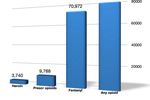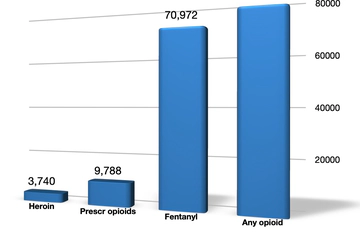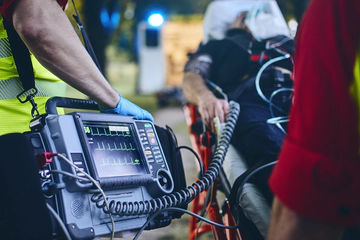
December 5, 2024

December 5, 2024

November 28, 2024


“Pink cocaine,” a new drug mixture, has arrived in Texas following distribution in major U.S. cities and Latin America. Despite the name, it seldom contains cocaine and is instead a risky mix of drugs like ketamine, MDMA, methamphetamine, and fentanyl. The drug’s pink coloring is meant to attract users, but its unpredictable ingredients make it extremely dangerous.

November 2, 2024


With fentanyl involved in 81% of adolescent overdose deaths—often disguised as common medications like Xanax or Adderall—a much better understanding of this threat is needed by parents, teachers, and others. These counterfeit pills are leading to fatal outcomes, especially among young men, highlighting the urgent need for awareness and prevention.

September 19, 2024


Xylazine continues to spread across the U.S., often mixed with fentanyl and other substances. This veterinary sedative causes severe ulcers, increases the risk of fatal overdose, and can’t be reversed with naloxone. Its rise is worsening the drug crisis, creating life-threatening risks for users who unknowingly consume it in illicit drugs.

July 11, 2024

May 16, 2024


Ecstasy rose in popularity in the late 20th century as a party drug. Today, it is still used at music festivals, raves, dances, bars and nightclubs, and in other social settings. The drug has serious harmful side effects and is addictive. Ecstasy should be avoided, as just one instance of using the substance puts the user at risk for adverse effects, including addiction and death.

May 9, 2024


Prescription drug abuse has become a serious issue of concern in the U.S., a public health crisis tied in closely with the rise in opioid abuse across America. Prescription drugs that have addictive, mind-altering effects are now quite popular amongst drug users, indicating a need for a multi-faceted public health response.

February 15, 2024

January 18, 2024


A survey out of New York City found something quite alarming. According to the survey, about 80% of IV drug users in New York City tested positive for fentanyl, but only 18% intended to use that specific drug. These findings showcase the harmful issues of fentanyl being laced into the drug supply, how most addicts don’t go looking for this drug, and how many users end up getting it in their system anyway, almost always without knowing.

December 28, 2023


Colder and darker climates are associated with heavier alcohol consumption, more frequent instances of alcohol poisoning, and a high risk for alcohol-related car crashes. Not only are people more likely to drink, they are more likely to drink in greater quantities, more often, and in dangerous ways. Inclement weather and poor driving conditions make drunk driving during winter even more dangerous, and the cold weather has the potential to prevent drinkers from being as aware of how much they’ve consumed and the effect the alcohol is having on them.

December 27, 2023


Research shows winter is the worst season for drug overdoses in states where the temps drop and snow sets in. Cold weather, social isolation, hampered travel, slower emergency response times, and other factors all make this season more dangerous for drug users. All of those factors combined increase the urgency for those who struggle with drug addiction to enter qualified residential drug treatment centers as soon as possible.

December 14, 2023


It’s not often discussed, but the frequency with which alcohol is consumed and the volume by which it is consumed have both increased considerably in recent years. Further, newly published research suggests a direct connection between increased frequency and volume of consumption and a newly reported increase in alcoholic liver disease fatalities, as such fatalities now represent nearly half of all annual liver-related fatalities.

November 23, 2023

November 9, 2023


According to a recent study, the use of hallucinogens among young people doubled between 2018 and 2021. The findings indicate a concerning shift in youth drug use trends with far more American adolescents, teens, and young adults experimenting with potent mind-altering hallucinogenic substances than in years prior.

October 26, 2023

October 19, 2023


According to a recent report, illicit ketamine drug busts and seizures by law enforcement skyrocketed by 349% between 2017 and 2022. Ketamine has been in use for years as a tranquilizer medicine for veterinary practices and hospital applications, but now the sedative is a major drug of choice among addicts and recreational drug users.

October 12, 2023

October 5, 2023


Around 80% to 90% of people who need drug and alcohol addiction treatment do not receive it, and for those who do, it is sometimes inadequate to provide them with the tools they need to overcome their addiction. And in addition to the people who accurately perceive they need treatment, millions more aren’t seeking treatment at all, even though they need it.

September 21, 2023

September 7, 2023


Ketamine has been used recreationally in the U.S. for some time, but only recently have usage rates increased significantly, and only recently has the drug become a major drug of concern. Law enforcement offices are reporting spikes in ketamine busts and seizures, and hospitals are increasingly reporting ketamine chemicals in ER patients.

August 1, 2023

July 27, 2023

June 15, 2023

June 7, 2023

June 5, 2023


A new research paper published by the CDC tracked a 300% increase in overdose deaths caused by fentanyl between 2016 and 2021. According to the study’s authors, this is the single sharpest increase in drug-related deaths in such a short amount of time since America’s addiction epidemic began in the early 2000s.

May 17, 2023

April 27, 2023


The Centers for Disease Control and Prevention recently released their provisional count for fatal overdoses in 2022, highlighting that about 6,000 fewer Americans died from drugs in 2022 than in 2021. If the provisional figures are accurate, 2022 will represent the first year that drug-related fatalities dropped since 2018.

April 13, 2023


Statistically, Generation Z has been consuming less alcohol than Millennials, Gen X, or Baby Boomers. There could be myriad reasons for this, but it would be worthwhile to examine the cultural shift and attempt to isolate some of the reasons why young people consume less alcohol than previous generations...

March 16, 2023

March 14, 2023


The Centers for Disease Control and Prevention published their life expectancy data for 2021, and the findings show Americans experienced their second year in a row of a drop in life expectancy. Several leading health and medical institutions, including the CDC and Harvard Health, are now pointing to drug overdoses as a primary contributing factor to the drop in life expectancy.

March 13, 2023

March 9, 2023


Research from the Substance Abuse and Mental Health Services Administration shows about one in eight children live in a household where at least one of their parents regularly abuses drugs and alcohol. Given what is known about the intergenerational nature of addiction, this means at least 12.5% of U.S. youths are at extremely high risk for developing addiction later in life simply as a result of their at-home living situation.

February 9, 2023


A significant percentage of young people undergo their first exposure to mind-altering drugs by simply consuming leftover medications they found in the family medicine cabinet or elsewhere in the home. Because it is far easier to prevent someone from using drugs than treat addiction once the person is hooked, families should commit to creating substance-free homes.

January 5, 2023


Recent data from the Centers for Disease Control and Prevention suggest a slight leveling-out in overdose deaths across the U.S. This has led some to believe the worst of the addiction epidemic has passed. Unfortunately, no leveling-out or even a downturn in overdoses will become stable and lasting if effective treatment options are not made available to the 23 million addicts at constant risk of an overdose.

December 27, 2022


When illicit fentanyl production first became a serious problem in the United States, it was almost entirely a trafficking problem, with the fentanyl being made in Mexico and China and then trafficked to the U.S. But according to recent DEA reports, many clandestine labs have cropped up on U.S. soil, labs which are making the potent synthetic opioid and distributing it locally, especially in the form of counterfeit pills.

December 15, 2022


During the pandemic, admissions to addiction treatment centers dropped by about 25%. That same year, fatal drug overdoses hit the highest year-over-year increase ever recorded, a 30% spike according to the Centers for Disease Control and Prevention. These findings suggest that having access to drug rehab is truly lifesaving.

November 24, 2022


Even as opioid prescribing rates decline, a few thousand doctors are still responsible for the significant overprescribing of opioids to the broader public. With that in mind, the American people will not overcome the opioid epidemic until all doctors and prescribers agree to adopt more conservative, cautious prescribing guidelines as outlined by the CDC.

November 18, 2022


Since 2019, there have been 171 verified overdoses in Michigan that were traced back to a non-opioid animal tranquilizer called xylazine. That number is likely an undercount, but it is the most recent number Michigan toxicologists have published. Often without addicts knowing, drug dealers lace the tranquilizer into other drugs to create an extended high. Unfortunately, combining xylazine with other drugs increases users' risk for an overdose.

November 17, 2022


Decades of scientific efforts have sought to understand why some people become addicted to drugs and others do not. One research paper suggests the issue is far simpler than what many believed. According to the data, anyone and everyone are at risk for drug and alcohol addiction, hence the importance of educating the public about this critical health risk.

November 10, 2022


Drug addiction affects everyone differently. While such a crisis is unique to the individual, certain demographics face challenges one might not find elsewhere. For example, military veterans who become addicted to drugs and alcohol often feel disinclined to discuss their problems or seek addiction treatment.

November 1, 2022


A recent study has shown that since 2020, youth harm from drug abuse has skyrocketed. Further, this harm has occurred in a very peculiar way. While overall drug use rates have mostly stayed the same for young adult demographics, the harm from drug use (accidents, injuries, overdoses, and fatalities) has skyrocketed. Primarily because of the types of drugs being used, substance abuse is now far more dangerous for young people than it used to be.

October 30, 2022


New research has chronicled the alarming rise in methamphetamine-related deaths over the last few years. In the findings, analysts were able to identify where in the U.S., meth-related deaths have been occurring the most. The overwhelming majority of them are happening in rural counties across America. So what has caused the spike in rural methamphetamine overdoses?

October 27, 2022


Newly published research into youth drug use trends indicates an alarming, unpredicted surge in hallucinogen use. Those who are now hooked will need help getting off such drugs. Further, understanding what prompted the surge will be crucial in preventing more young people from experimenting with mind-altering drugs.

August 17, 2022

July 14, 2022

July 7, 2022

June 29, 2022


Inhalants refer to a broad range of household and industrial chemicals whose volatile vapors or pressurized gases cause a mind-altering effect when breathed through the nose or mouth. Such vapors produce intoxication in a manner not intended by the manufacturer. In fact, many of these substances are actually poisonous to inhale, and they carry warning labels that specifically caution people not to inhale them.

June 23, 2022


If a drug has the potential to create mind-altering effects in those who use it, then that drug has the potential to cause harm. And while hallucinogenic drugs do not cause the high overdose rates or critical public health crises associated with other narcotics, such substances are still physically and mentally debilitating and overall quite harmful. This article aims to cover basic trends in usage and the statistics surrounding hallucinogen abuse in the United States.

June 22, 2022


Not all mind-altering substances receive equal attention from the media, policymakers, and public health officials. But any drug has the potential to harm the user, hence the importance of understanding usage trends and statistics for all drugs. This article briefly highlights relevant trends and statistics regarding club drug usage.

June 9, 2022

June 7, 2022

June 2, 2022


Though it is not often mentioned by the media, there is a broader economic cost to the national public health emergency of drug and alcohol addiction. Addiction is expensive, not just for addicts, but for all Americans. Conversely, solving America’s addiction epidemic and returning millions of recovering addicts to the workforce would benefit the economy.

May 25, 2022

May 4, 2022

May 2, 2022


Researchers at the University of New England found that the rate of opioid-related cardiac arrests has risen dramatically and is now on par with the rate of cardiac arrest from other causes. The research sheds light on yet another major health risk connected to opioid addiction, i.e., the risk for suffering a potentially fatal heart complication.

April 26, 2022

April 14, 2022

March 9, 2022